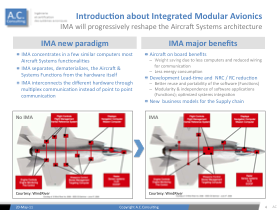Integrated Modular Avionics

Decrease of Part Number
Impact on operations
The technological maturation of the aerospace industry in the past 20 years has disguised the concentration of Aeronautical systems suppliers. Today only a handful of them account for 90% of the equipment activity turnover. The consequence of this concentration is both the elevation in their position in the aircraft value chain and the increased breadth of participation in development activities for new platforms
Among these systems suppliers a special role appears for those in charge of the system backbone of the aircraft: the Integrated Modular Avionics (IMA). The IMA system is really acting as the nervous spine of the aircraft: the point of unity for receiving, distributing and processing information for the internal and external systems. It is highly likely that all systems in the future will have to deal with this digital spine. Using the analogy of the human body, this spine has a vital role and if you master it you master all the aircraft “organs”.
Principles of IMA: Simplify Avionics into hardware and software standard functions
The goal with IMA is to make avionics systems as simple as a network of PCs : imagine you can shop, install or uninstall standards-compliant software for your avionics systems in much the same way you do it on your PC
-
1.IMA concentrates in a few similar computers most Aircraft Systems functionalities
-
2.IMA separates, dematerializes, the Aircraft & Systems Functions from the hardware itself
-
3.IMA interconnects the different hardware through multiplex communication instead of point to point communication
Evolution of hardware versus software
Imagine you can shop, install or uninstall standards-compliant software for your avionics systems in much the same way you do it on your PC.
Multiplex communication







